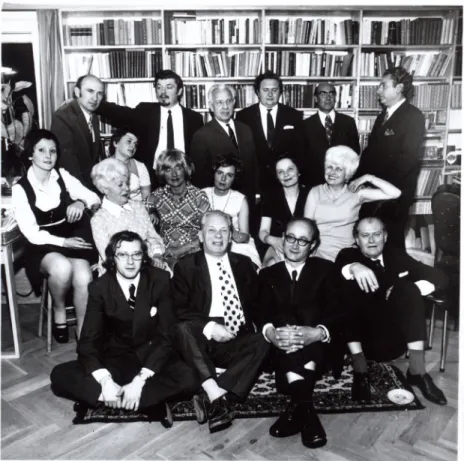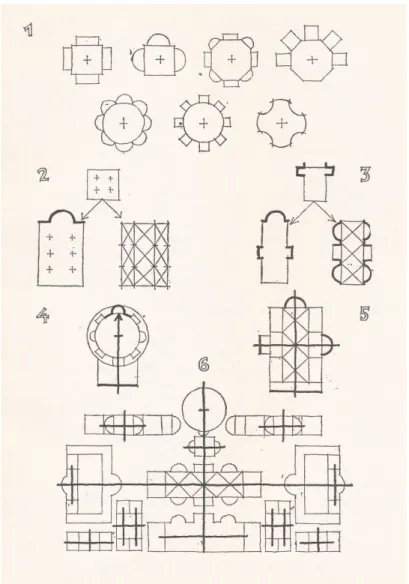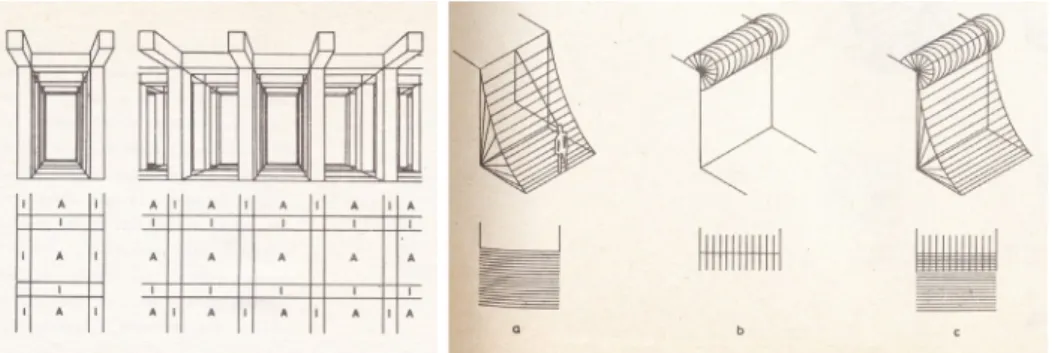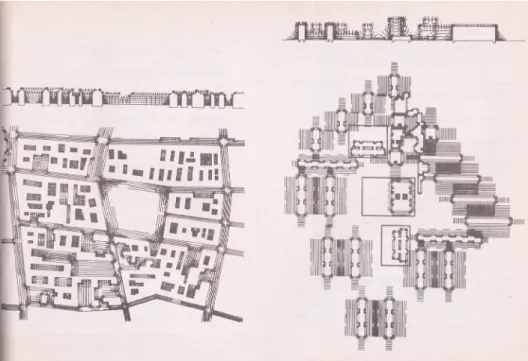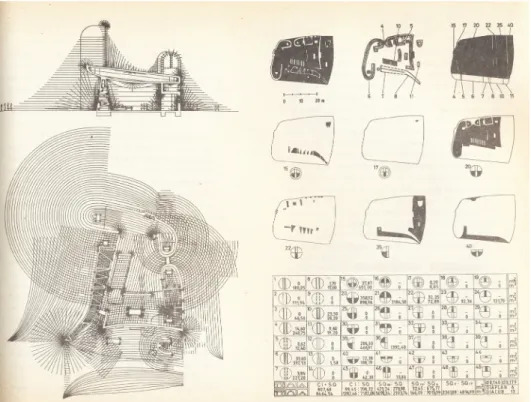© 2020 The Author
ANALYTICAL SPACE THEORIES AND GYULA HAJNÓCZI’S SPATIOLOGY
#JÁNOS KRÄHLING
Dr. habil., head of department, professor. Department of History of Architecture and Monument Preservation, BME K II. 82, Műegyetem rkp. 3, 1111 Budapest, Hungary.
Phone: (+36-1) 463-1330. E-mail: krahling@epk.bme.hu
Gyula Hajnóczi’s scientific career is characterized by the intertwined cultivation of ancient architec- tural history of the Antiquity, architectural theory, and the preservation of monuments of the Antique world. From the late 1960s onwards, the need to develop a new theory of architecture became more and more pronounced in his researches, which was completed in the 1980s with the creation of the analytical space theory called Spatiology. This paper aims to analyse his complex analytical research methodology in the international research context. Hajnóczi’s research method of analysing the architectural space includes also the socially and psychologically determined factors of spatial perception. According to his analytical theory, the constructive-initiative medium can initiate spatial relations called vallum and inter- vallum, and by referring their quantitative survey, the definition of spatial qualities can be interpreted in relation to building, man and space in a wholistic approach. Architectural creation is theoretically approached in this duality, from the point of view of quantitative and qualitative characteristics.
Hajnóczi’s work is little known internationally, however, by comparing and analysing it with the researches of his contemporaries, it can play an important role in the international research context. It is considered as one of the relevant theoretical architectural achievements in Hungary in the second half of the 20th century.
Keywords: Gyula Hajnóczi, theory of architecture, Spatiology, analytical theory of space
INTRODUCTION
In the thematic richness of Gyula Hajnóczi’s scientific career three disciplines appear of exceptional interest which are inseparably combined into a whole oeuvre: the his- tory of architecture of Antiquity, architectural theory, and the preservation of archi- tectural monuments of Roman Pannonia. In my approach I would like to grasp from this rich oeuvre the importance of his researches in the field of architectural theory, also highlighting its architectural history context (Fig. 1).
The framework and symbolic milestones of theoretical research are set out in the textbook of “History of Architecture – Antiquity” published in 19671 and in his dis- sertations: in 1966 for the degree Candidate of Technical Sciences with the disserta-
1 Hajnóczi, Gyula: Az építészet története – Ókor [The History of Architecture – Antiquity]. Tankönyvkiadó, Budapest 1967. 462 pages, 632 figures. A book review by László Castiglione. Periodica Polytechnica Architecture 12 (1968) 4. 111–112.
# This work was supported by the National Cultural Fund of Hungary (NKA) under Grant Number 101108/547.
tion Development of Spatial Approach in the Architecture of Antiquity, and in 1978 for the title of Doctorate in Technical Sciences of the Hungarian Academy of Sciences (DSc) with his main theory work titled Prolegomena for the Objective Evaluation of Architectural Creation – Analytical Theory of Architectural Space.
THE NEW TEXTBOOK OF THE HISTORY OF ARCHITECTURE OF ANTIQUITY WITH A NEW THEORETICAL BACKGROUND
The unfolding of Hajnóczi’s architectural work can be traced back to the sixties.
By placing Hajnóczi’s intellectual legacy in a broader context, we can grasp one of the most valuable strands of architecture theory researches in Hungary in the dec- ades before the change of regime, which is also of outstanding significance in ar- chitectural thinking in East Central Europe. In a study by M. Simon written in connection to two theoretical writings of Hajnóczi,2 she accurately drew the posi- tion and novelty of his research on the form of architecture, also interpreting it in an international context.3 The theoretical clarification of modern architecture in the 1960s, following the work of Giedion, Zevi, Blake, Banham and others, was just the opposite approach to the Marxist ideology of Hungarian architecture, which, following Máté Major’s theoretical approach, provided a theoretically grounded answer operating with the dichotomy of content and form to the problem of archi- tectural space.
2 Hajnóczi, Gy.: Az építészeti forma jelentéséről [On the Meaning of the Architectural Form]. Építés- és Közlekedéstudományi Közlemények 4 (1960) 1–2. 51–59.; Hajnóczi, Gy.: Architectural Meaning. Periodica Polytechnica Architecture 30 (1986) 1–4. 71–79.
3 Simon, Mariann: Az építészeti formáról. Hajnóczi Gyula két írása a hatvanas évek tükrében. Építés- Építészettudomány 26 (1996–1997) 3–4. 279–288.
Figure 1. Gyula Hajnóczi
(Photo: BME Department of History of Architecture and Monument Preservation, 1970’s)
It is obvious that in the then Department of History of Architecture lead by Máté Major, the Marxist-oriented writing of architectural history was decisive,4 yet, Gyula Hajnóczi’s new textbook on the architecture of Antiquity used an approach in which contemporary economic, social, cultural conditions, building materials and structures, architectural technology appeared in a balanced presentation against style analysis or the one-sided validation of societal relations in a Marxist ideological context (Fig. 2).
4 Cf. Moravánszky, Ákos: The Specificity of Architecture. Architectural Debates and Critical Theory in Hungary, 1945–1989. Architectural Histories 7 (2019) 1. 1–12. DOI: https://doi.org/10.5334/ah.315 (accessed 12 November 2020).
Figure 2. The Department in a party meeting, first row from right:
Gyula Hajnóczi, Zoltán Szentkirályi, Máté Major, Gábor Hajnóczi; middle row from right Erzsébet Cs. Tompos, Margit B. Szücs, Edith H. Sipos, Mrs. Caesar Herrer, Katalin Merényi,
Mrs. Máté Major, Márta Borsányi; back row from right: Mihály Zádor, Alajos Sódor, Ferenc Vámossy, László Vargha, Gyula Istvánfi, Csaba Virág
(Photo: BME Department of History of Architecture and Monument Preservation, 1970’s.)
Although Major himself wrote a thorough architectural history discussed in three volumes on a purely Marxist ideological basis,5 in his open-minded departmental workshop it was possible to apply a different theoretical approach to this main trend, which allowed the department to be a progressive workshop for Hungarian architec- tural and theoretical research. This atmosphere is characterized by a footnote written to one of the basic theoretical texts of the great contemporary, Zoltán Szentkirályi, with which Major allowed to publish the study in his academic journal: “We present this study not only because of its positive qualities … and its interest, but also be- cause we consider it to be one-sided in its approach, and therefore to be discussed.
It would be good if those colleagues dealing with the theory of architecture and art would comment on it... ”.6
In Hajnóczi’s studies on the history and theory of architecture, a new approach raised many important and system-related issues concerning the question of how the periods discussed affected later historic eras. In this context, he not only examined the influence of the Eastern world on Ancient Rome, but also built on the conceptu- al basis according to which the ancient Western world tangibly articulated the legacy from which Europe was born. In its interpretation, Classical also means European, even if later history has nuanced and coloured this fundamental idea. Moreover, building on all this, this conceptual base later led to a change in his historical-theo- retical approach of architecture, according to which Hajnóczi characterized the architectural processes from the Early Modern Age until the beginning of the 20th century with the concept of Memorism.7
The theoretical basis of his textbook was determined by his university doctoral (dr. univ.) dissertation (Spatial Forms and Spatial Connections in Ancient Roman Architecture, 1961). The theme of his dissertation for the title of Candidate of Technical Sciences exploring the development of spatial approach of Antiquity indi- cates that the subject matter of his study is increasingly turning to spatial theory. The approach to space formation that can be read from the matrix of spatial forms and spatial relations has now become the subject of his research not only in relation to the architecture of Antiquity, but also in the whole spectrum of historical architecture.
Here the work discussing the architectural history of Antiquity and the problem of the theoretical anatomization of the architectural space meet.
A peculiar grimace of fate is that his candidate’s dissertation, although having a signed contract with a publisher, could not be published in book form – it is not possible to reconstruct whether for his non-Marxist approach or for other reasons.
5 Major, Máté: Geschichte der Architektur 1–3. [History of Architecture 1–3]. Henschelverlag, Belin/
Akadémiai Kiadó, Budapest 1957.
6 Szentkirályi, Zoltán: A térművészet történeti kategóriái [Historical Categories of Space Art]. Építés- és Közlekedéstudományi Közlemények 11 (1967) 2. 263–313. In French: Szentkirályi, Z.: Catégories historiques de l’art d’espace. Periodica Polytechnica Architecture 15 (1971) 1–2. 81–143. (Translation by the author)
7 Hajnóczi, Gyula: Memorizmus [Memorism]. In Lővei, P. (ed.): Horler Miklós hetvenedik születésnapjára – tanulmányok [Studies in Honour of Miklós Horler for His Seventieth Birthday]. (Series Művészettörténet–
Műemlékvédelem IV.) OMVH, Budapest 1993. 501–506.
Later, however, the publication became possible in the form of a journal article, and this may have been a symbolic event in the history of the Faculty of Architecture of BME: the faculty’s scientific periodical started with his research results published as a full-length article titled Space and Ideas (Fig. 3).8
8 Hajnóczi, Gy.: Space and Ideas. Periodica Polytechnica Architecture 12 (1968) 2. 3–99. Online source:
https://pp.bme.hu/ar/article/view/2530/1635 (accessed 12 November 2020).
Figure 3. Hajnóczi, Gy.: Types of spatial connection in Roman architecture (Source: Hajnóczi, Gy.:
Space and Ideas. Periodica Polytechnica Architecture 12 (1968) 2. 1–99 – here Plate XI. p. 93
A NEW THEORY OF SPACE IN HUNGARY IN THE 1980S – SPATIOLOGY
His candidate’s dissertation is the antecedent of his academic DSc dissertation Prolegomena for the Objective Evaluation of Architectural Creation – The Analytical Theory of Architectural Space, which is one of the highlights of the entire oeuvre.
This work later matured into a book published by Akadémiai Kiadó under the title Vallum and Intervallum first in German, then in Hungarian.9 The events of the career of the professor just outlined, including the space theory research that has developed since the 1960s, are of special value to the writings of architectural theory in Central and Eastern Europe.10
According to Prolegomena, the particularity of the architectural creative process is the relationship between mass and space, their dual alignment to each other, as characterized by a contemporary Hungarian architectural theoretician, Zoltán Szentkirályi: space as the antinomy of mass and mass as the antinomy of space.11 In the interpretation of the relationship between mass and space, quantitative analysis refers to the mass-like, structurally defined vallum and intervallum is determined by
9 In German: Hajnóczi, Julius Gy.: Vallum und Intervallum – eine analytische Theorie des architektonischen Raumes. Akadémiai Kiadó, Budapest 1988. In Hungarian: Hajnóczi, Gyula: Vallum és intervallum – az építé- szeti tér analitikus elmélete [Vallum and Intervallum – An Analytical Theory of Architectural Space].
Akadémiai Kiadó, Budapest 1992.
10 Some important reviews on Hajnóczi’s theory: Ankerl, G.: Vallum und Intervallum. Schweizer Ingenieur und Architekt (17. November 1988.) 47; Krcho, Jan: Vzt’ah človeka a architektonického priestoru. Projekt Revue Slovenskej Architektúry 3 (1989) 53.; Moravánszky, Ákos – M. Gyöngy, Katalin: A tér. Kritikai antológia [The Space – A Critical Anthology]. TERC, Budapest 2007. 237–250; Moravánszky, Ákos: The Specificity of Architecture. Architectural Debates and Critical Theory in Hungary, 1945–1989. Architectural Histories 7 (2019) 1. 1–12. DOI: https://doi.org/10.5334/ah.315 (accessed 12 November 2020).
11 Szentkirályi, Z.: Catégories historiques de l’art d’espace. Periodica Polytechnica Architecture 15 (1971) 1–2, 89.
Figure 4. a) Space creating ability of support-beam structures;
b) Heterogeneous conspersive and dispersive spatial relations
(From: Hajnóczi, Gy.: Épület- és településkarakterológia [Building and Settlement Characterology].
OTKA Research Report in Print, BME Sokszorosító, Budapest [1991.] pp. 38, 82)
the so-called “constructive-initiative medium”,12 and the aim of qualitative spatial analysis is to explore the process of examining and analysing the subjective accept- ance of space (Fig. 4a–b). All this complex entanglement of mass and space is char- acterized by the spatial relations and proportions that can be described by the rules of geometry, that traces the architectural spatial analysis – in Hajnóczi’s words – back to a quasi-two-bit or black-and-white basic relationship.13 The architectural space bounded by various architectural elements – foundation, floor, walls, ceiling, or even a row of pillars, vaults, glass walls – and with its material properties, size, shape, proportions, decorations and lighting characterize not only the architecture of Antiquity, but also the architectural culture of millennia in general.
Architectural creation is theoretically approached in this duality, from the point of view of quantitative and qualitative characteristics. He analysed the structural medi- um of space – the structure-lead history of architecture – with the rules of geometry, while the qualitative characteristics were disaggregated into spatial types, moreover, taking into account the rules of human perception and also the field of psychology
12 In Hungarian: konstruktív-iniciatív közeg.
13 Hajnóczi, Gyula: Vallum és intervallum – az építészeti tér analitikus elmélete. Akadémiai Kiadó, Budapest, 1992. 15.
Figure 5. Spatial relations of a closed and loosely built-up part of a settlement
(From: Hajnóczi, Gy.: Épület- és településkarakterológia [Building and Settlement Characterology].
OTKA Research Report in Print, BME Sokszorosító, Budapest [1991.] p. 350)
he laid down the theoretical foundations of Spatiology – the methodology and disci- pline elaborated by his researches. In addition to the internal spatial relations, the external spaces delimited by architectural ensembles are also dealt with in the study, which makes urban environments also become part of the issues of spatial creation – we can learn more about its practical adaptability from Péter Hajnóczi’s doctoral research (Fig. 5).14
The quantitative and qualitative numeric analysis and interpretation of space the- ory – that is the spatiological evolution – in relation to the main periods of architec-
14 Hajnóczi, Péter: A térmennyiség és términőség vizsgálatának építészeti értékelése [Architectural Evaluation of the Investigation of the Quantity and Quality of Space]. In Hajnóczi, Gy. (ed.): Appendix – a 283.
számú OTKA kutatás (1988–1991) zárójelentése [Appendix – Final Report of OTKA Research No. 283 (1988–1991)], [Printed manuscript] [1991.] II. rész [Part Two], pp. 12–28. For a contemporary analysis meth- odology of space syntax cf. Fleischmann, M. – Feliciotti, A. – Romice, O. – Porta, S.: Morphological Tessellation as a Way of Partitioning Space: Improving Consistency in Urban Morphology at the Plot Scale. Computers, Environment and Urban Systems 80 (2020) 101441. https://doi.org/10.1016/j.compenvurbsys.2019.101441 (accessed 12 November 2020).
Figure 6. Ronchamp – qualitative and quantitative spatial analysis following the methods of Spatiology (From: Hajnóczi, Gy.: Épület- és településkarakterológia [Building and Settlement
Characterology]. OTKA Research Report in Print, BME Sokszorosító, Budapest [1991.] p. 275)
tural history was elaborated by involving some key monuments of the periods. This analysis appears to be a heroic work – note that at that time the digital technology available to everyone today was not yet at hand, but these directions – the use of digital tools and the interpretation of virtual space – make his theory relevant today and methodologically much easier to apply (Fig. 6).15
SPATIOLOGY AND ITS THEORY CONTEXT
As outlined above, Hajnóczi’s studies of space theory began in the 1960s and by 1978 became a consistent theory with the Prolegomena, resulting in the scientific methodology of analysing the architectural space called Spatiology. After the elabo- ration of Prolegomena, in the course of the research project (supported by OTKA, the Hungarian National Research Fund)16 for the development of Spatiology to prac- tical applicability, and by the progress in the publication in book format Hajnóczi could determine a critical reference to the space researches carried out by Herbert Muck, a professor at the Akademie der Bildenden Künste in Vienna.17 This provided an opportunity for Hajnóczi to place the foundations of the Prolegomena into a crit- ical context by referring to the human dimensions and social relations of architecture.
Looking at his references it appears obvious that, contrary to Muck’s interpreta- tion, Hajnóczi’s position is much more complex, including the socially and psycho- logically determined factors of spatial perception. According to Hajnóczi’s Spatiological method, or, in other terms, according to his analytical theory of space, a constructive-initiative medium initiates spatial relations, including external and internal aspects, and based on this ability, the definition of spatial qualities can be interpreted in relation to man and space. The quantitative analysis of these spatial quality categories leads to the establishment of spatial characterology.
Spatiology can be paralleled with, or more precisely, it can precede the architec- tural research processes in the field of architectural theory in international context, which have highlighted only one aspect from the sub-areas covered by Hajnóczi’s complex analytical methodology. Such a parallel initiative is, for example, the meth- od of analysis based on visual exploration and perception of space, the spatial de- scription with “isovists”, according to Tandy’s theory (1967)18. Michael L. Benedikt
15 Mezős, T.: A térmennyiség számítógépes megállapításának módja [The Determination of the Amount of Space by Computer]. In Hajnóczi, Gy. (ed.): Appendix – a 283. számú OTKA kutatás (1988–1991) zárójelen- tése. [Appendix – Final Report of OTKA Research No. 283 (1988–1991)] [Printed manuscript] [1991.] II. rész [Part Two], pp. 19–21.
16 Hajnóczi, Julius Gy. (témavezető): Épület- és településkarakterológia. OTKA kutatás, 283. sz. 1988–
1991. [Hajnóczi J. Gy. (lead researcher): Building and Settlement Characterology – Research project supported by OTKA (=the National Scientific Research Fund) No. 283. 1988–1991.]
17 Muck, Herbert: Der Raum. Baugefüge, Bild und Lebenswelt [The Space. Structure, Image and Living Environment]. Akademie der Bildenden Künste Institut für Sakrale Kunst, Wien 1986.
18 Tandy, C. R. V.: The Isovist method of Landscape Survey. In H. C. Murray (ed.): Symposium. Methods
of Landscape Analysis. Landscape Research Group, London 1967. 9–10.
(1979) later introduced analytical measurement methods for qualitative spatial and environmental representations based on isovists. This process greatly contributed to the practical applicability of the method based on visual space analysis.19 Tandy and Benedikt’s method marked the main direction of analytical spatial studies in Western architectural culture, which later expanded to include spatial perception-centric and other disciplines, among others also graph theory to its methodology, leading then with the proliferation of digital techniques to the development of analytical methods that could be performed with a computer.20 At the same time, the essential difference between the application of isovists and Hajnóczi’s theory is that while isovist theory considers only the visual revelation – and thus excludes the subject-defined social determinism of space – Hajnóczi’s theory aims at the complexity of spatial analysis:
in addition to multifaceted and precisely defined quantitative characteristics, it in- cludes the immanent attitude to the intellectual history approach, spatial psychology, the designer’s and recipient’s aspects, as well as the possible social dimensions of spatial quality, completed with an analysis focusing on the historic development of architectural spaces. He argues that architectural environment is an “objectified form of human behaviour” that should be interpreted not only in relation to the building and space, but also in relation to man and space.21
Miloutine Borissavlievitch’s comparative critical study of architectural theories (1926)22 was one of the thought reference works for the conceptual basis of Spatiology, for its geometric proportion analysis, and for the development of a comprehensive and critical history of architectural theory. However, an essential difference is that Borissavlievitch forced the application of perspective according to independent prin- ciples in the critical evaluation of all theories, thus resulting in a reduced approach.
The relevance of Hajnóczi’s theory is indicated by the fact that the need to use analytical architectural theory was articulated in several ways at the end of the 20th century. The need for renewal in the field of humanities is represented by the theo- retical work of Jon Lang (1988), who attempts to formulate normative design theory based on, among other things, the results of research in behavioural science.23
19 Benedikt, M. L.: To Take Hold of Space: Isovists and Isovist Fields. Environment and Planning (1979) B 6. 47–65.
20 Turner, A. – Doxa, M. – O’Sullivan, D. – Penn, A: From Isovists to Visibility Graphs: A Methodology for the Analysis of Architectural Space. Environment and Planning B: Planning and Design (2001) 28, 103–121.
21 Hajnóczi, Gy.: Az építészeti tér genezise. Bevezető [The Genesis of Architectural Space. Introduction].
In Hajnóczi, Gy. (ed.): Appendix – a 283. számú OTKA kutatás (1988–1991) zárójelentése. [Appendix – Final Report of OTKA Research No. 283 (1988–1991)] [Printed manuscript] [1991.] IV. rész – zárótanulmány [Part Four – Final Study].
22 Borissavlievitch, Miloutine: Les Théories de l’Architecture. Payot, Paris 1926. For Borissavlievitch’s theory cf. Stanković, Nebojša: Milutin Borisavljević and His Scientific Aesthetics of Architecture. Serbian Studies: Journal of the North American Society for Serbian Studies 22 (2008) 2. 133–147. DOI: https://doi.
org/10.1353/ser.2008.0004 (accessed 12 November 2020).
23 Lang, Jon: Understanding Normative Theories of Architecture – the Potential Role of Behavioral Sciences. Environment and Behavior 20 (1988) 5. 601–632.
CONCLUSION
This brief overview highlights the extent to how Gyula Hajnóczi’s theory of archi- tecture with its theoretical basis and methodology may appear as a considerable chapter in the European architectural culture of the second half of the 20th century and is still relevant today. It is not so well known, perhaps because of the kind of in-depth focusing integrated character and understanding of the extremely complex structure of space theory that is not so easy to apply in a simplicist form. The other reason is that although it was published in German, and then in Hungarian, it re- mained quite limited to the international readership, the English edition is still wait- ing for completion. Its effect can basically be traced in Hungarian theory writing.
In addition to his space theory, he also wanted to process an outline of another intellectual challenge, the history of architectural theory from Antiquity to the 20th century. The book would have been the textbook of the subject History of Architecture Theory, that is also taught today in architecture education at BME, and he had active- ly worked on the manuscript until his death in 1996. The first part of the work – which presents the history of theory from Antiquity to the end of the Renaissance – was published in this periodical,24 the reconstruction of the second part from manuscript fragments can be an important task for Hungarian architecture theory researchers for the future.
Gyula Hajnóczi’s intellectual legacy is present in the teaching of architecture, his books are in use, and his theory is known to interested students. If university archi- tecture education were to have a properly equipped spatial theory research laborato- ry, Spatiology might play an essential role in this initiative. Hajnóczi’s theory would be worthy of this: the comprehensive approach developed from the study of the spatial view of the architecture of Antiquity should be considered as one of the rele- vant Hungarian architectural and intellectual achievements of the second half of the 20th century.
ANALITIKAI TÉRELMÉLETEK ÉS HAJNÓCZI GYULA SPACIOLÓGIÁJA
Összefoglaló
Hajnóczi Gyula tudományos pályáját az ókori építészettörténet, az építészetelmélet és az antikvitás műemlékvédelmének egymásba fonódó művelése jellemzi. Az 1960-as évek végétől egyre markánsab- ban jelenik meg egy új építészetelmélet kidolgozásának igénye, amely az 1980-as években a Spaciológia- ként elnevezett analitikus térelmélet megalkotásával vált teljessé.
A cikk célja ennek az építészeti térre vonatkozó komplex analitikai kutatási módszertannak elemzése a nemzetközi kutatások tükrében. Hajnóczi építészeti térelméleti kutatási módszere magában foglalja a
24 Hajnóczi, Gyula: Az építészetelmélet története. Építés- Építészettudomány 26 (1996-1997) 3–4. 207–277.
térészlelés társadalmilag és pszichológiailag meghatározott tényezőit is. Analitikai elmélete szerint a konstruktív-iniciatív közeg határozza meg a vallum és intervallum fogalmakkal meghatározott térbeli kapcsolatokat, majd ennek a kvantitatív elemzése alapján a térbeli minőségek meghatározása az épület, az ember és a tér vonatkozásában komplex módon értelmezhető. Az építészeti alkotás elméletileg ebben a kettősségben ragadható meg, kvantitatív és kvalitatív jellemzőivel. Hajnóczi munkássága nemzetközi- leg kevéssé ismert, azonban kortársainak kutatásaival összehasonlítva és elemezve fontos szerepet játszhat a nemzetközi kutatásokkal párhuzamba állítva. Műve a 20. század második felében hazánk egyik releváns elméleti építészeti eredményének számít.
Kulcsszavak: Hajnóczi Gyula, építészetelmélet, Spaciológia, analitikus térelmélet
ANALYTISCHE RAUMTHEORIEN UND GYULA HAJNÓCZIS
„SPACIOLOGIE“
Zusammenfassung
Die wissenschaftliche Karriere von Gyula Hajnóczi ist von der Verflechtung der Architekturgeschichte der Antike, der Architekturtheorie und der Erhaltung von Denkmälern der antiken Welt geprägt. Ab den späten 1960er Jahren wurde die Notwendigkeit, eine neue Architekturtheorie zu entwickeln, in seinen Forschungen immer deutlicher, die er in den 1980er Jahren mit der Schaffung der analytischen Raumtheorie namens Spaciologie abgeschlossen hat. Dieser Beitrag zielt darauf ab, seine komplexe analytische Forschungsmethodik im internationalen Forschungskontext zu analysieren. Hajnóczis Forschungsmethode zur Analyse des architektonischen Raums umfasst auch die sozial und psycholo- gisch bestimmten Faktoren der räumlichen Wahrnehmung. Nach seiner analytischen Theorie initiiert das konstruktive-initiative Medium räumliche Beziehungen, die als Vallum und Intervallum bezeichnet werden, und unter Bezugnahme auf ihre quantitative Untersuchung kann die Definition räumlicher Qualitäten in Bezug auf Gebäude, Mensch und Raum in einem ganzheitlichen Ansatz interpretiert wer- den. Das architektonische Schaffen wird theoretisch in dieser Dualität unter dem Gesichtspunkt quanti- tativer und qualitativer Merkmale angegangen. Hajnóczis Werk ist international wenig bekannt. Durch den Vergleich und die Analyse mit den Forschungen seiner Zeitgenossen kann es jedoch eine wichtige Rolle im internationalen Forschungskontext spielen. Es gilt als eine der relevanten theoretischen archi- tektonischen Errungenschaften in Ungarn in der zweiten Hälfte des 20. Jahrhunderts.
Schlüsselwörter: Gyula Hajnóczi, Architekturtheorie, Raumkunde, analytische Raumtheorie
Received: 10 December 2020. Accepted: 12 December 2020 First published online: 6 March 2021
Open Access statement. This is an open-access article distributed under the terms of the Creative Commons Attribution 4.0 International License (https://creativecommons.org/licenses/by/4.0/), which permits unrestricted use, distribution, and reproduction in any medium, provided the original author and source are credited, a link to the CC License is provided, and changes – if any – are indicated. (SID_1)

